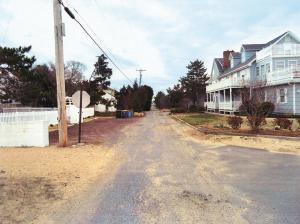Lewes' Bay Avenue work to begin in fall
Work is expected to begin in the fall to rebuild Lewes’ Bay Avenue at a cost of about $3 million to install new water and sewer lines and resurface the street. It will be the most costly project of its kind ever in the city.
About 25 people who live on or near the street, attended a Lewes Street Improvement Committee meeting April 13 at City Hall.
“Public safety, health and welfare is really where we are with this project,” said Ted Becker, chairman of the street committee and a Lewes City Councilman.
Vince Luciani, an engineer with George, Miles & Buhr, said 70 percent of the project’s design is complete.
He said requests for construction bids would go out in July and work should begin this fall.
Luciani said two construction schedules are being considered: An aggressive one that would take nine months and calls for completion of the project in June 2012, and a 16-month schedule that would end in December 2012. No decision has yet been made.
Utility installation
Luciani said state drinking water law requires a separation of 10 feet between water and sewer lines. To install the lines, construction equipment must straddle the trench for each line. Because there needs to be room for equipment and workers, putting the lines in would encroach 6- to 10-feet onto private property.
“Internally, we struggled with that setback,” Luciani said. He said property disturbance beyond the city’s right of way line will be restored by the contractor. Private improvements within the city’s right of way must be relocated at homeowner expense.
Luciani showed a computer-altered photograph of the street’s appearance after completion.
“That looks like a boulevard if the trees are gone,” said Bay Avenue homeowner Robin Lester. Becker said over the years, homeowners have planted vegetation on city property and now some or all of it must be removed to install utilities.
Some homeowners grumbled, saying the city doesn’t have the right to come onto their property. But Becker said the city’s attorney has checked, and the city does have the right to encroach on and disturb private property to install utilities.
Luciani said the only way a contractor would be able to install utilities would be to clear-cut vegetation and remove fencing and anything else obstructing where contractors need to excavate.
Continued service
Luciani said there would be no extended loss of water or sewer services during the project because the contractor would restore service at the end of each workday.
“In a worst-case scenario, you’ll be without water for half a day,” Luciani said.
In areas of Bay Avenue where the right-of-way is 12-feet wide, any disturbance beyond the right-of-way line would be restored to existing condition by the contractor, Luciana said.
In areas of Bay Avenue where the right of way transition is 32 feet, on the bay side of the avenue the disturbance line has been established as the right-of- way line.
On the Cedar Avenue side of Bay Avenue, the disturbance line is 6- to 10-feet from the edge of the proposed paving.
Existing improvements in this area such as landscaping and trash enclosures must be removed or relocated before construction begins. Engineers would begin laying out the limit of disturbance within the next month or two, Luciani said.
He said in June and July, a George, Miles & Buhr representative would meet with individual homeowners to discuss work at their property.
Roadway surface
Luciani said the porous asphalt that would be used on Bay Avenue makes it a high-maintenance street. “This porous asphalt is tricky to maintain,” he said. The asphalt would be placed atop a foot of rock. Because it’s porous, the surface serves as a stormwater management system. Sand, however, can clog the pores. The asphalt was used at Iowa and Bay avenues, but has not performed well. Luciani said core samples are being taken to try to determine why it failed.
He said the porous roadway would need to be vacuumed 12 to 16 times a year to ensure proper drainage.
Roadway width
Lewes Fire Department Chief Wally Evans said during first discussions about the project the department sought a 16-foot wide roadway but conceded to a 12-foot width. He said some Bay Avenue residents would like to see that width shrink to 8 feet, but that isn’t possible.
“Our trucks are 8-feet wide, mirror-to-mirror. The ladder truck requires 16 feet with stabilizers extended. If someone’s trapped down there and we can’t in, you’re going to be asking, ‘Why didn’t we do this when we had the chance?’” Evans said.
Reversing one-way flow
Becker said the city isn’t going to reverse the flow of traffic on Bay this summer to see how it works.
He said homeowners would have to move their mailboxes twice – once during the trial period, and again after construction.
Members of the street commission think changing the one-way travel direction to be north to south, would reduce traffic on the street. Also under consideration is whether to bring Bay Avenue out on Savannah Road or to reverse traffic from Market Street on.
Lewes Police Chief Jeffrey Horvath said initially, the traffic pattern would be confusing. He said he wanted to see a traffic flow plan to better understand how it would work.
The completed Bay Avenue wouldn’t have sidewalks, curbs or gutters. Becker said the street committee is sensitive to the needs of pedestrians and bicyclists. He said the panel has discussed traffic-calming devices such as speed bumps and decided not to use them.























































